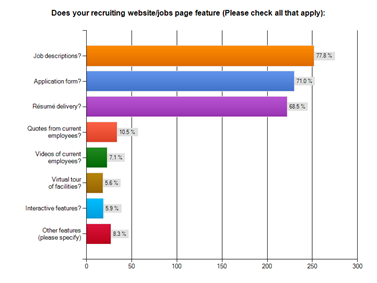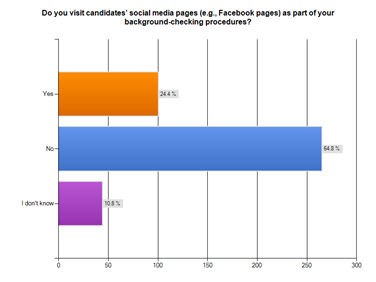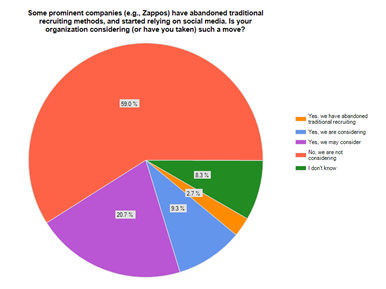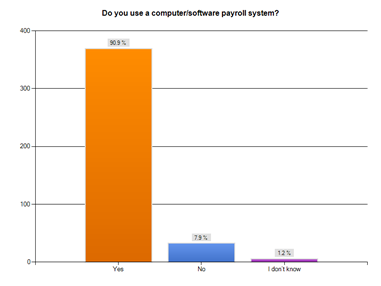Our HR Technology Survey sought to learn how tech advancements are changing the face of human resources—and how professionals in the field are adapting. Are new systems affecting recruiting strategy? Are they assisting with productivity, both in the HR department and in businesses as a whole? And, perhaps most importantly, how far can HR pros really trust tech when making decisions?
Highlights of the HR Technology Survey:
- 26.1% of participants find technology to be helpful in all HR arenas.
- By far, payroll is the HR function for which technological solutions are the most embraced. 41.3% of participants responded that it is one of the arenas in which tech is most helpful, and just under 91% currently use a computer/software payroll system.
- Abandoning traditional recruiting in favor of relying entirely on social media has been in the news lately—but about 59% of participants said that they are not even considering such a strategy.
- 17.5% of respondents do not spend any time on—or have the budget for—researching or implementing new technologies.
- There is considerable skepticism among participants as to how far tech can be trusted in making HR decisions. 31.7% trust technology only in the minority of their decisions—and slightly over 19% don’t trust it at all.
Who Participated?
A total of 483 individuals participated in this survey, conducted in January and February 2015. Respondents hailed from all across the United States and worldwide, with the largest percentages of participants reporting from the East Central and Southern United States (these regions both made up 18.5% of the response pool). 9.5% of participants identified themselves as responding from non-U.S. or international organizations.
Of those who identified themselves, the majority (59.6%) represent privately owned companies, 21.2% are with nonprofit organizations, 10.9% work for public entities, and government organizations represented the smallest portion at 8.4%.
The positions of respondents ran the gamut from staff-level employees (14.8%) to executives (19.9%). The smallest group represented was supervisors at 5.9%, and the largest group was managers, which made up 48.2% of the response pool.
Recruiting Websites, Jobs Pages, and Applicant Tracking Systems (ATS)
Perhaps unsurprisingly, the vast majority of respondents (73.4%) have a recruiting website or jobs page on their company website. The most prominent features on these job pages were job descriptions, application forms, and résumé delivery.

Respondents were fairly evenly split on use of an ATS, but the majority do not have one—43.4% employ an ATS, 52.7% indicated that they don’t have such a system, and 3.9% responded “I don’t know.”
Social Media, Talent Pools, and ‘Googling’ Candidates
The great majority of respondents (61.4%) do not encourage social media interaction between current employees and potential hires, and employers tend not to visit social media pages while conducting background checks—64.8% indicated that they do not include such a step in their preemployment processes, while 24.4% do.


Participants were more likely to conduct Internet searches on potential hires than to visit their social media pages, but this form of background check was still in the minority. 32.2% perform an Internet search on candidates, while 58% do not.
Only about a quarter (24.5%) of participants indicate that they use social media or software to develop talent pools to tap into when job openings become available. Almost 10% did not know if their organization used technology for talent pooling.
Is Traditional Recruiting on the Decline?
The short answer is no. Only 12% of respondents said that they are considering abandoning or have completely abandoned traditional recruiting methods in favor of social media à la Zappos. A resounding majority of 59% say that they are not considering the abandonment of traditional recruiting.
That’s not to say that change isn’t possible in the future—20.7%, or a little over a fifth, of participants said that they “may” consider this approach.

Payroll Systems
Technology is clearly favored when it comes to payroll. An overwhelming 90.9% of participants said that they use a computer/software payroll system, while only 7.9% do not employ technology for this function.
When asked what vendor or software they used for payroll, 23% of the 342 participants who responded indicated that they use ADP. Other programs included (but were not limited to):
- Paychex (6% of respondents)
- Sage (4%)
- PeopleSoft (also 4%)
- QuickBooks (2%)

Healthcare Benefits
Various online features are employed by a large portion of the response pool, with the most popular tech aspect of healthcare benefits being online account management (45.2% of participants offer this as part of their healthcare benefits package). However, it is somewhat surprising that 37.6% of participants said that they do not offer online/tech tools to help manage healthcare benefits.
Areas Less Affected by Tech
Technology does not seem to have taken over the realm of wellness management among participants—only 14.7% said they had a technology-based wellness system, while 79.1% said they did not (6.2% didn’t know).
Other arenas where tech has not appeared to make many inroads include replacement and succession planning (95.4% do not have a software or system), mentoring (89.5% do not employ tech), and tracking employee productivity (only 10.8% track individual productivity).
Be on the lookout for tomorrow’s Advisor, where we’ll share more results from our survey—including the effect of technology on HR costs, productivity, and decisions.
